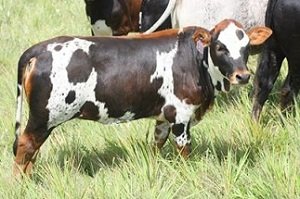andybob
Well-known member
What are everyones' thoughts on raising locally adapted breeds which need minimal inputs, while capable of producing more lbs/acre than larger less adapted breeds? In the African context, the Nguni is capable of thriving in very harsh environments while needing the minimum of supplements, as hide colour is not discriminated against, and payment at point of slaughter is based on grade x price/lbs.
As packes encourage ranchers to raise larger framed cattle for better economy of throughput for their factories, would the better option be to create a premium market for quality pasture raised locally adapted cattle?
What are the thoughts on this type of native or naturally adapted breeds - Nguni tricoloured calf picture to add to the discussion;
As packes encourage ranchers to raise larger framed cattle for better economy of throughput for their factories, would the better option be to create a premium market for quality pasture raised locally adapted cattle?
What are the thoughts on this type of native or naturally adapted breeds - Nguni tricoloured calf picture to add to the discussion;

